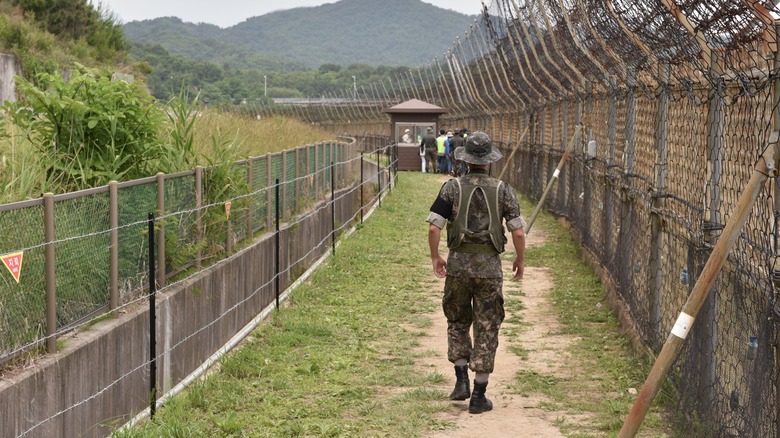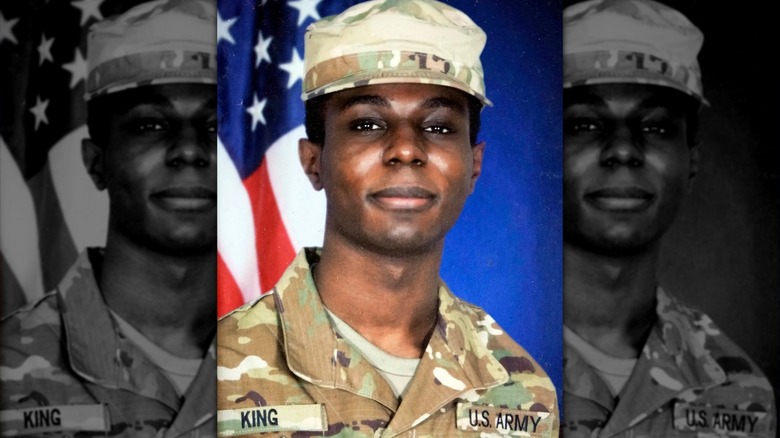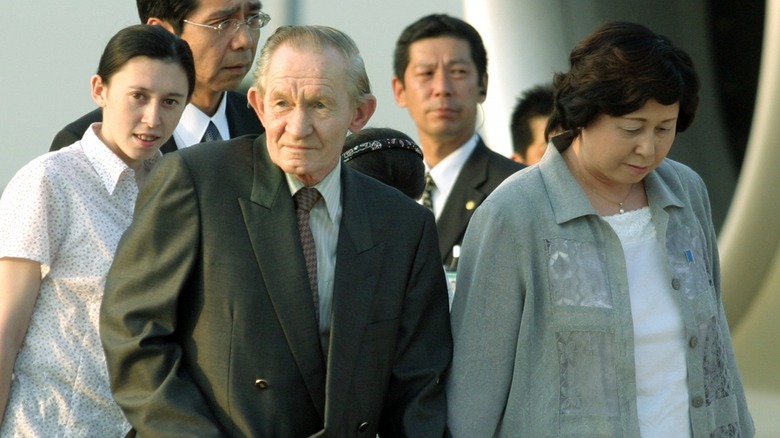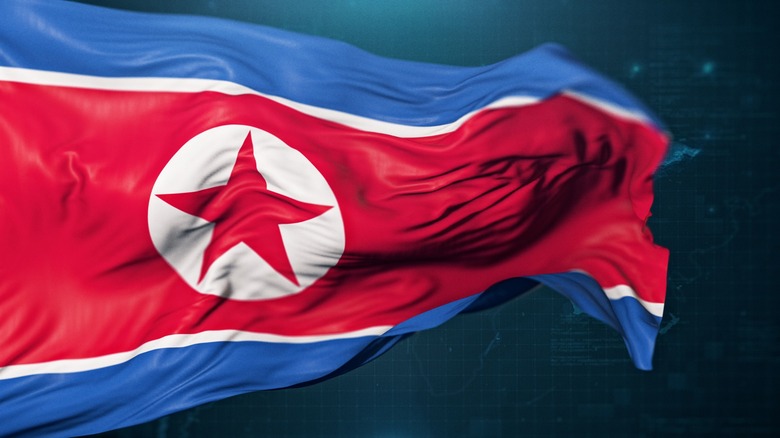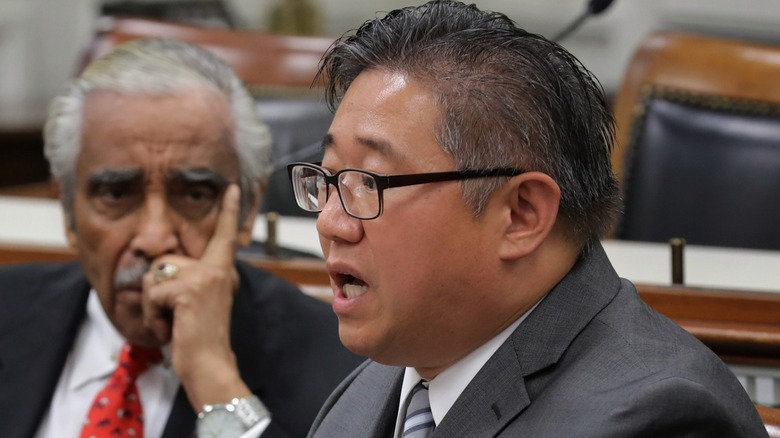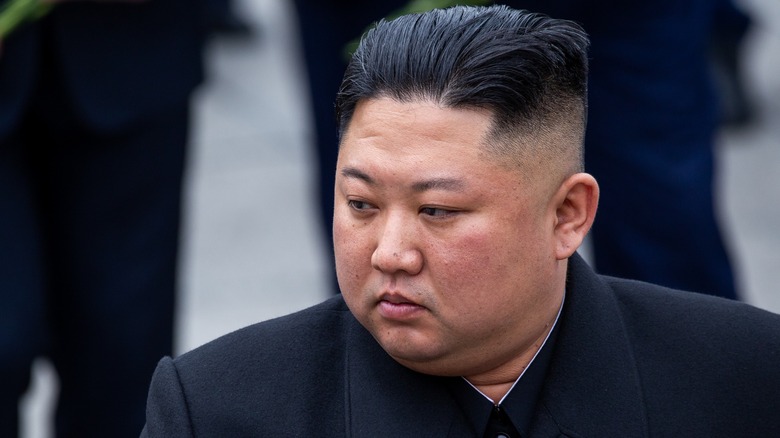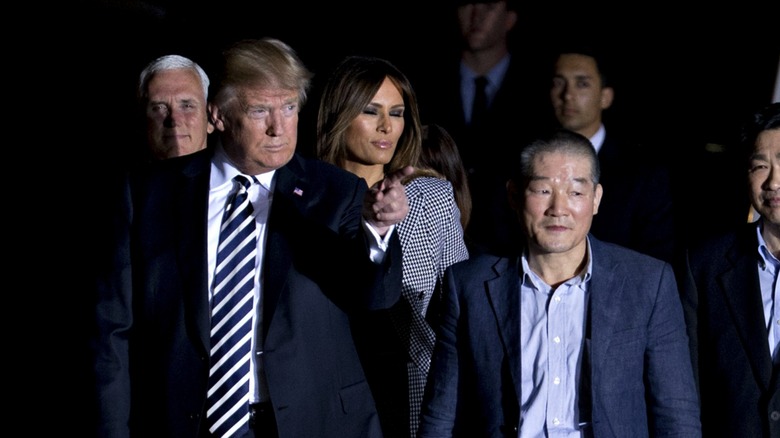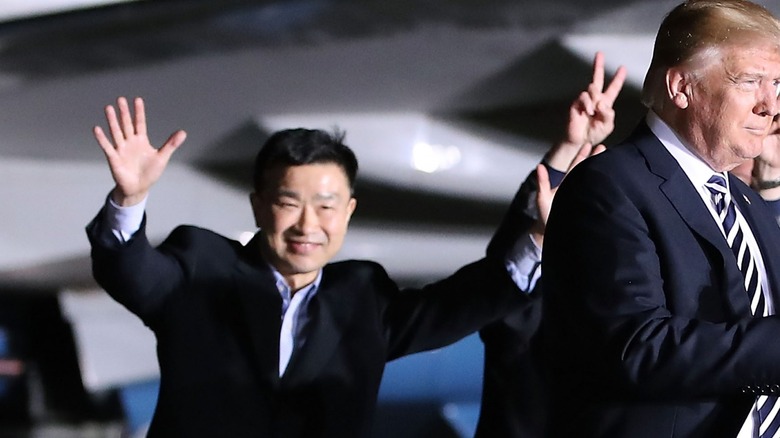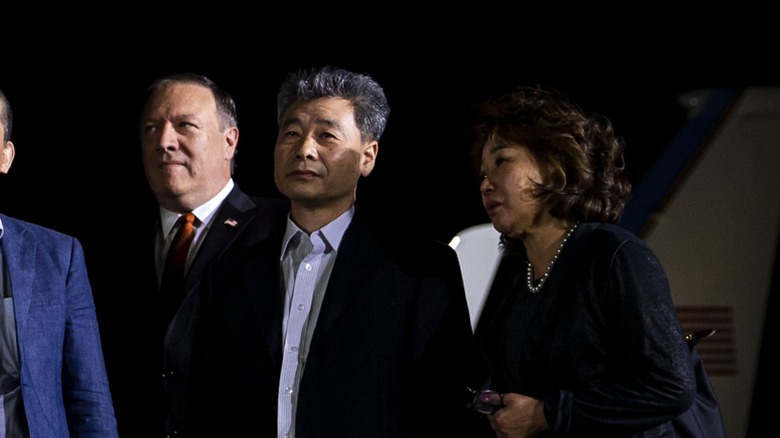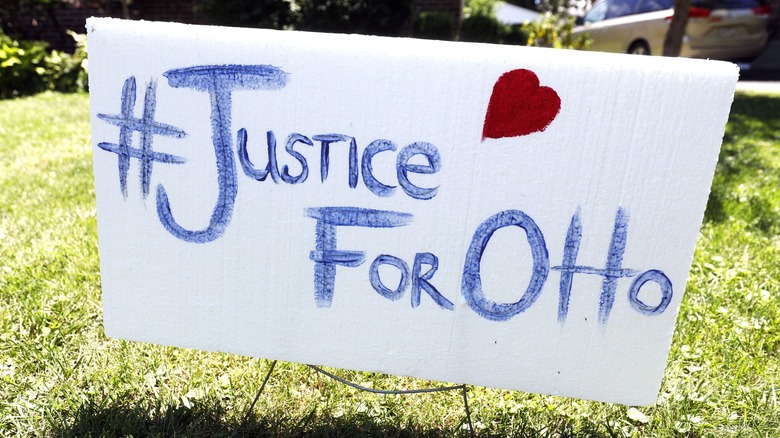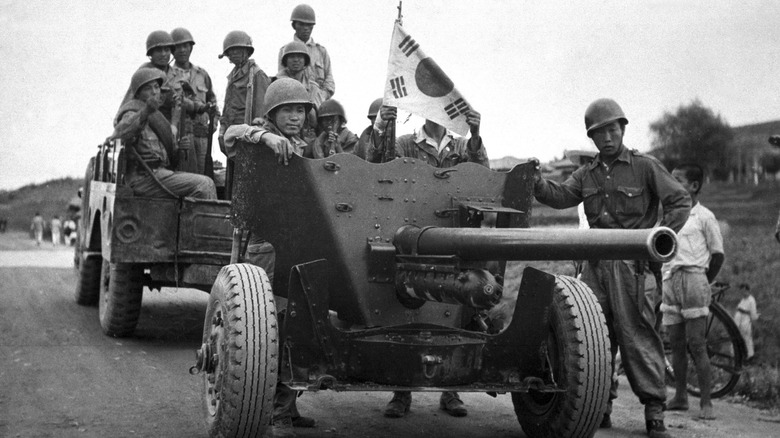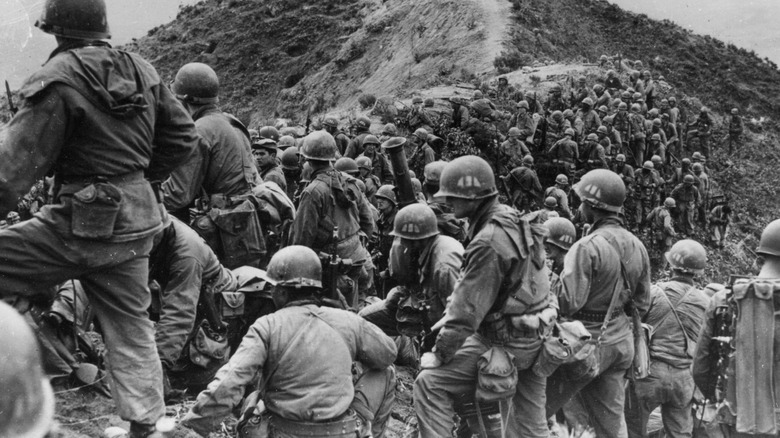Americans Who've Crossed Into North Korea Throughout The Years
Even though the United States and North Korea are no longer engaging in active combat against each other, diplomatic tensions are still strained to say the least. Problems between the two countries mainly date back to the mid-20th century and the end of the Second World War. In 1945, following the war, the country was divided in two, with America taking responsibility for the southern half of Korea below the 38th parallel, while the Soviet Union occupied the area to the north.
Following the North Korean invasion of the South in 1950, the two countries were at war for three years, finally signing an armistice to stop the bloodshed in 1953. Known as "the Forgotten War" by many because of its lack of historical attention relative to other engagements like Vietnam and World War II, it's thought that around 5 million people lost their lives amidst the fighting.
To this day, there has never been an official peace treaty, making diplomatic relations tough. In fact, the State Department has North Korea listed on its Travel Advisory list under a Level 4: Do Not Travel warning. The U.S. still does not even have an embassy in the country and directs its citizens to work with the Swedish embassy instead. As you can imagine, Americans crossing the border into North Korea is mostly forbidden, and incredibly dangerous. Though it doesn't happen often, it garners worldwide attention, and at times even heightens fear of a resumption of fighting.
Travis King
On Tuesday, July 18, 2023, Travis King etched his name in the history books of the Korean War, but for all the wrong reasons. A 23-year-old serving as a Pvt. 2nd Class in the United States Army, King made the shocking decision to illegally cross through the Demilitarized Zone (DMZ) and over the North Korean border. At the time, it was not clear exactly why King made such a dangerous decision, though he did have a lengthy disciplinary record that may have played a role.
Just prior to crossing the border, King had apparently served time in South Korean prison and been fined nearly $4,000 over an ugly, drunken incident earlier in the year. Officials were trying to take King back to the United States, but he escaped the custody of his escorts and fled. Coincidentally, there was a civilian tour of the area near the DMZ when King ditched his escorts, and he somehow joined them. When he saw his opportunity, King ran across the DMZ and into North Korea, where his fate is unclear as of this writing.
North Korea refused to comment on the situation, leaving a complete mystery as to what happened to him after he was almost surely taken into custody. King left behind a family stateside, who was distressed about his potential whereabouts. We may never know why King did what he did, but hopefully, he has remained safe and healthy.
Charles Jenkins
In January 1965, Sgt. Charles Jenkins of the U.S. Army made what turned out to be the biggest mistake of his life. Under the influence of alcohol and unhappy with life stationed in South Korea, Jenkins decided to voluntarily cross the border into North Korea. He gave himself up to North Korean authorities, who quickly brought him in for questioning. They immediately disabused Jenkins of any notions of freedom, and he endured beatings and forced education.
After a failed escape attempt in 1966 along with other American captives, Jenkins soon found himself an unwilling North Korean citizen, forced to do work for the government and military. Not allowed to leave the country, Jenkins eventually got married in the 1980s to another captive of the North Koreans, Hitomi Soga, who was from Japan. They had two kids together, but Jenkins was shocked by the inhumanity and poverty he saw in the country. Though he had better accommodations than many citizens, including government rations, Jenkins still lived in squalid conditions.
Jenkins finally left the country for Japan in 2004 and was allowed to join his wife (pictured above), who was released from North Korea in 2002. However, when Jenkins arrived in Japan he faced U.S. military court over his desertion four decades prior, which he was convicted of. Jenkins always wanted to return home to North Carolina, but never did, passing away in Japan in 2017 at the age of 77.
Matthew Miller
The case of Matthew Miller's arrest and incarceration in North Korea is one of the more bewildering in recent history. Miller was first detained in North Korea in April 2014 after traveling to the country with a tour group. Details were sketchy, but it appeared at the time that Miller had sought asylum in North Korea. Five months later, Miller was convicted at trial of espionage charges, and sentenced to six years of hard labor. He was accused of working under the "protection and encouragement of the current U.S. government," though it was unclear whether or not that was actually true (according to The New York Times).
Though he was given a six-year sentence, Miller ended up not serving the majority of his time, and he was back in the United States that November. In an interview with NK News published a week later, Miller explained that he had in fact deliberately tried to seek asylum in North Korea. However, he denied working with the U.S. government or having any plans for espionage. Instead, Miller claimed he genuinely was curious about the people in North Korea, and he wanted to learn about them first-hand.
Things could have gone much worse for Miller during his time in North Korea, and he was extremely lucky to have been released as quickly as he was without enduring severe torture and abuse. He was released along with fellow American Kenneth Bae, who had been there for two years.
Kenneth Bae
Religious proselytization can be a powerful motivator, and in Kenneth Bae's case, it was important enough for him to risk his life in North Korea in order to spread the gospel. Bae is a native of South Korea but a naturalized American citizen from Washington, and he found himself captive in North Korea for two years from 2012–2014. Bae's reason for being in North Korea was missionary work, but he disguised it as a travel business that operated out of China. However, North Korean authorities caught on to his ruse, and in late-2012 he found himself under arrest and, soon after, on trial.
North Korean courts sentenced him to 15 years of hard labor, which took a toll on his physical health. He had to go to the hospital multiple times during his two years in the country, wracking up $300,000 in medical charges — a bill that is apparently still outstanding. As a prisoner, Bae claims to have faced long bouts of intensive interrogations, but never any physical abuse at the hands of his captors. He was allowed to read messages from his family and had limited communication, but had to confess to trying to subvert the North Korean government.
The North Koreans released Bae in November 2014, almost exactly two years after his initial detainment. He was the longest-held American prisoner in the country at the time of his release, and ended up writing a book about his experiences after his release called "Not Forgotten."
Jeffrey Fowle
In 2014, tensions between the United States and North Korea were beginning to ratchet up for several reasons, part of which was due to the imprisonment of several American nationals. In addition to the detainments of both Kenneth Bae in 2012 and Matthew Miller that April, Ohioan Jeffrey Fowle also found himself on the wrong side of the North Korean government in May 2014. Similar to Bae, Fowle was arrested for allegedly trying to spread the Christian faith to North Korea, where proselytizing is strictly prohibited.
Fowle's crime was allegedly leaving a Bible inside his hotel room while visiting the country as a tourist. He was allowed limited communication with his family during his detainment, and he was released in October before being convicted of any crimes. Fowle was lucky because North Koreans often consider leaving around religious material, like Bibles, to be a form of proselytizing. Fowle may have been looking at more than a decade in prison sentences, like his fellow captive Bae, who was initially sentenced to 15 years of hard labor.
Fowle was released after almost 6 months in captivity, just a few weeks before Bae and Miller were in November. Fowle's release came at the direction of North Korean dictator Kim Jong-un (pictured above) and was very unexpected. As you would expect, his family was there to meet him when he finally arrived back home in Ohio, very eager to see him after many tough months apart.
Kim Dong-chul
Almost as if out of a Lee Child book, the story of Kim Dong-chul's incarceration in North Korea is as stunning as it is incredible. Dong-chul was an American citizen who began living in North Korea in 2002. He was originally from South Korea but had moved to the United States in his late 20s, before moving back to Asia in China in 2000. He ran a hotel in North Korea called the Tamangang Hotel — which required extensive bribing of the government — and was very successful.
However, Dong-chul claims he quickly started moonlighting as an undercover intelligence agent, working against the North Koreans. He allegedly supplied the CIA and South Koreans with information on the North Korean military, which eventually led to his 2015 arrest and 10-year prison sentence. After spending just over two years in a prison camp, Dong-chul was released and sent back to the United States.
His time in the prison colony had been incredibly tough, with little food and back-breaking labor. He did have some limited contact with other imprisoned Americans, and was released in May 2016 alongside fellow detainees Kim Hak-song and Tony Kim. Once back stateside, Dong-chul reunited with his wife and two daughters, relocating to New York and writing a book on his experiences, aptly titled "Border Rider."
Tony Kim
In April 2017, United States citizen Tony Kim found himself in an unenviable predicament. Tony was under arrest by the North Korean government on alleged charges against the state. He had been working at the Pyongyang University of Science and Technology at the time of his arrest, after previously working at a different university in southern China. As usual, at first, it was unclear why Tony , who also went by his Korean name of Kim Sang-duk, was detained and arrested by the authorities, but it may have been due to his work with orphanages in the country.
In addition to Tony, his colleague from Pyongyang University Kim Hak-song was also placed under arrest. Tony was not formally charged or sentenced to any prison time following his detainment, and he was eventually released in May 2018, almost exactly a year after his initial arrest at the Sunan International Airport in Pyongyang. Tony was released with his colleague Hak-song, as well as with another American detainee, Kim Dong-chul.
Like the other arrests, it was speculated that Tony's detainment may have been an attempt to exert leverage on diplomatic relations with the United States, though it's unclear what North Korea received for his exchange. His release was orchestrated by former President Donald Trump's Secretary of State Mike Pompeo, and Trump Tweeted about their release as they were in the air on their way home.
Kim Hak-song
When news broke in May 2017 that the North Koreans had detained another American citizen, it was anything but welcome. Kim Hak-song was the fourth American arrested and detained in the country since 2015, and was a colleague of Tony Kim, another American who had been in custody for only a few weeks at that point. Both Hak-song and Tony worked at the Pyongyang University of Science and Technology, though it was unclear whether or not their arrests were related to each other.
Hak-song is a Chinese-American originally from Jilin, China, and had been back living in China shortly before moving to North Korea. According to an interview he gave with the National Catholic Reporter, the authorities arrested him because they thought he was trying to proselytize Catholicism. They pointed to emails he had sent to his church back in East Hollywood as evidence of his intent to spread religion.
However, authorities never convicted Hak-song of espionage or any other charges, and he was released before he ever went to trial. Hak-song was imprisoned in North Korea for almost a year to the day, and his imprisonment only strengthened his faith. He was released alongside his colleague Tony and fellow American detainee Kim Dong-chul. All three of them met with President Donald Trump upon their arrival, who humbly suggested he should be given the Nobel Peace Prize for his efforts in freeing them.
Otto Warmbier
By far, one of the most tragic cases of American citizens crossing into North Korea is that of former University of Virginia student, Otto F. Warmbier. Warmbier first found himself detained in North Korea in January 2016 after visiting the country on a tour. The North Koreans did not release a reason for his detainment at first, but he soon admitted that he had tried to steal a political banner from the hotel where he was staying. He also dubiously claimed that he was working with the CIA, though it is more than likely he was forced to say that as propaganda.
A few months after his arrest, Warmbier was sentenced to 15 years of hard labor. Apparently, he was offered a used car as a reward for stealing the poster, though again it's hard to know how much of his confession was true and not coerced. Just over a year into his prison sentence Warmbier was unexpectedly released. It is still unknown how or why, but Warmbier was in a coma upon his return home in June 2017.
He had entered the coma shortly after his imprisonment and trial, but American doctors could not figure out why. Sadly, Warmbier died just a few days after returning home, on June 19, 2017, at the age of just 22. In 2022, a New York court awarded Warmbier's family $240,000 from North Korea, but the details of his death are still largely a mystery.
Anna Wallis Suh or Seoul City Sue
Most people don't know her story today, but Anna Wallis Suh is one of the most infamous defectors in American history. Originally from Arkansas, Wallace moved to Korea to work as a missionary in the 1930s, before relocating to China just as World War II was breaking out (per The New York Times). Interned in China during the war, Suh returned to Korea after it ended and her husband got a job in the newly set up U.S. military government.
When the communists invaded in June 1950, the couple was still living in Seoul. However, they voluntarily stayed in the city as the North took over, soon playing a key part in the communist propaganda war on the radio. In the tradition of "Axis Sally" and "Tokyo Rose," Suh became derisively known as "Seoul City Sue" by American troops for her anti-American broadcasts. It is suspected Suh was potentially doing the broadcasts under duress, being forced to do so to save her and her husband's life.
The details of her life become fuzzy after the invasion of Seoul ended, though it's likely she continued to work for the North Korean government. According to former North Korean detainee Charles Jenkins in his autobiography "The Reluctant Communist," Suh was actually a double agent working for the South, which eventually led to her execution after being discovered. We'll likely never know the true story behind "Seoul City Sue," but it sure is a tantalizing tale.
James Joseph Dresnok
Among defectors to North Korea, James Joseph Dresnok probably has the most unique story. He was the second of four U.S. Army defectors to cross over the border in the early-to-mid-1960s, and he would end up growing to love his adopted country of North Korea more than his home country of America. Dresnok was struggling both professionally and emotionally while stationed in South Korea with the Army in 1962, and he decided to take a chance on life in the North, not really knowing what to expect.
At first, he rejected living in North Korea and tried to seek asylum at the Soviet embassy, but after that fell through he gradually started warming up to his new environment. He and his other captives were forced into becoming North Korean citizens, and they soon became movie stars, too. They starred in several North Korean films, portraying the Americans in a negative and brutal light, which made Dresnok very popular among his new neighbors.
In addition to being a movie star, Dresnok was also a translator and a college professor, teaching English. He created a new life and a new family in Pyongyang, including having three sons by two wives, and was at peace with his life in Korea at the time of his death. He rejected any possibility of leaving to return stateside, truly believing his best option was to remain in North Korea. Dresnok reportedly died in August 2017, at the age of 74.
